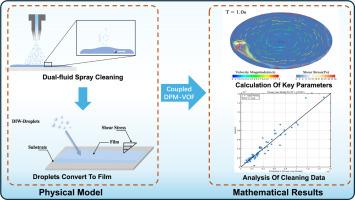Optimization of dual-fluid wafer cleaning system through CFD simulation and dimensional analysis of dynamic liquid film behavior
IF 3.9
3区 工程技术
Q3 ENERGY & FUELS
Chemical Engineering and Processing - Process Intensification
Pub Date : 2025-08-23
DOI:10.1016/j.cep.2025.110519
引用次数: 0
Abstract
As semiconductor devices continue to scale down, wafer cleaning is a critical step for manufacturing yield and device reliability. This study presents a framework integrating Computational Fluid Dynamics with experimental validation to investigate dual-fluid wafer cleaning by examining liquid film dynamics on rotating wafers. CFD simulations, coupling the Volume of Fluid and Discrete Phase Model approaches, modeled droplet impact, liquid film evolution, and key hydrodynamic parameters. These CFD predictions were validated through physical cleaning experiments using SiO2 nanoparticles. The validation demonstrated a correlation between simulated wall shear stress and experimentally measured wafer cleaning efficiency, and also between simulated film uniformity and experimental cleaning uniformity. Key findings indicate that while an increasing Reynolds number enhances turbulence and shear stress, it may compromise liquid film uniformity. Increasing the Weber number not only contributes to higher cleaning efficiency but also promotes more uniform liquid film coverage. An empirical equation derived from Re and We offers a predictive tool for liquid film thickness, intended for scalable cleaning process optimization. This work provides an experimentally validated theoretical and practical foundation for optimizing semiconductor wafer cleaning, contributing to considerations of efficiency and process scalability.

通过CFD仿真和液膜动态特性的量纲分析,优化双流体晶圆清洗系统
随着半导体器件的不断缩小,晶圆清洗是制造良率和器件可靠性的关键步骤。本研究提出一个结合计算流体动力学与实验验证的框架,通过研究旋转晶圆片上的液膜动力学来研究双流体晶圆清洗。CFD模拟,耦合流体体积和离散相模型方法,模拟液滴撞击,液膜演化和关键流体动力学参数。这些CFD预测通过使用SiO2纳米颗粒的物理清洗实验得到了验证。结果表明,模拟壁面剪切应力与实验测量的晶圆清洗效率之间存在相关性,模拟膜均匀性与实验清洗均匀性之间也存在相关性。关键发现表明,虽然雷诺数的增加增强了湍流和剪切应力,但它可能会损害液膜的均匀性。增加韦伯数不仅有助于提高清洁效率,而且可以促进更均匀的液膜覆盖。Re和We得出的经验方程提供了液膜厚度的预测工具,用于可扩展的清洁过程优化。这项工作为优化半导体晶圆清洗提供了实验验证的理论和实践基础,有助于考虑效率和工艺可扩展性。
本文章由计算机程序翻译,如有差异,请以英文原文为准。
求助全文
约1分钟内获得全文
求助全文
来源期刊
CiteScore
7.80
自引率
9.30%
发文量
408
审稿时长
49 days
期刊介绍:
Chemical Engineering and Processing: Process Intensification is intended for practicing researchers in industry and academia, working in the field of Process Engineering and related to the subject of Process Intensification.Articles published in the Journal demonstrate how novel discoveries, developments and theories in the field of Process Engineering and in particular Process Intensification may be used for analysis and design of innovative equipment and processing methods with substantially improved sustainability, efficiency and environmental performance.

 求助内容:
求助内容: 应助结果提醒方式:
应助结果提醒方式:


